Featured Comment
I have been making inarizushi for decades and this article opened my eyes in many ways. Will make use of all the “tips”!
★★★★★
– Jan
Ever looked at perfect hosomaki tuna rolls or chirashi sushi and thought, “Beautiful, but impossible”?
In this recipe, you’ll master inarizushi, the golden tofu pockets that make sushi feel easy again. And wait till you see the open-inari twist that turns simplicity into artful joy.

Inari Sushi
Recipe Snapshot
- What is it? Sweet-simmered tofu pouches stuffed with vinegared sushi rice.
- Flavor profile: Sweet, Savory, Delicate
- Why you’ll love this recipe: It’s an easy, no-roll sushi that fits your needs.
- Must-haves: Aburaage, Short (or medium) grain rice, Rice vineger
- Skill Level: Medium
- Suitable for Meal Prep? Yes!
Summarize & Save this content on:

What is Inari Sushi?
Inari sushi, or inarizushi (稲荷寿司), is one of Japan’s most beloved grab-and-go sushi dishes. It’s made by stuffing seasoned aburaage (thin fried tofu pouches) with lightly vinegared Japanese rice.
The name “Inari” traces back to Inari Ōkami, the Shinto deity of rice, harvest, and prosperity. At shrines dedicated to Inari, worshippers would offer fried tofu because foxes (believed to be the deity’s messengers) were thought to love it. Over centuries, that offering evolved from a temple ritual into a comforting, everyday food.
Today, inari sushi is a staple in Japanese home cooking, bento boxes, and convenience stores alike.
Inarizushi Ingredients

- Japanese light soy sauce (usukuchi shoyu): A clean, salty shoyu that seasons without darkening, so your inari skins stay a soft golden-blond. Look for bottles labeled “Usukuchi” at Japanese/Asian grocers. If you only have regular Japanese shoyu, use it. It will just look a shade deeper.
- Aburaage (fried tofu pouch): Thin, puffy tofu sheets that open into pockets and soak up sweet-savory broth. Grab the square, airy kind (easier to slit and open) from the freezer or refrigerated tofu case at Asian or Japanese stores. I will explain more in detail in the next section.
- Dashi stock: Usually awase dashi made with kombu plus katsuobushi. Use leftover homemade awase dashi if you have it, otherwise tea-bag style dashi packets or instant dashi granules are perfect for the small amount here. Make kombu-shiitake vegan dashi if you wanna go plant-based.
How to Choose Tofu Pouches (Aburaage) for Inari Sushi
If your goal is a quick inari sushi, the tofu pouch you pick will determine how easy the process feels, how neat your inari look, and how well they hold up.
- Personally recommend: Thin, square aburaage (usuage) is best balance of easy to open, evenly sized, absorbs seasoning fast).
- Fastest route: Ready-seasoned inari pouches (no simmering), but check labels for bonito dashi and wheat-based soy sauce if you need vegan/gluten-free.
- Personally don’t recommend: Kyo-age (京揚げ) or Mukashiage (昔揚げ).
| Type | What it is | Ease of opening | Best for |
|---|---|---|---|
Aburaage (thin, “usu-age”) | Uniform, thin, puffy | Easy, layers separate cleanly | In most cases |
Ready-seasoned inari pouches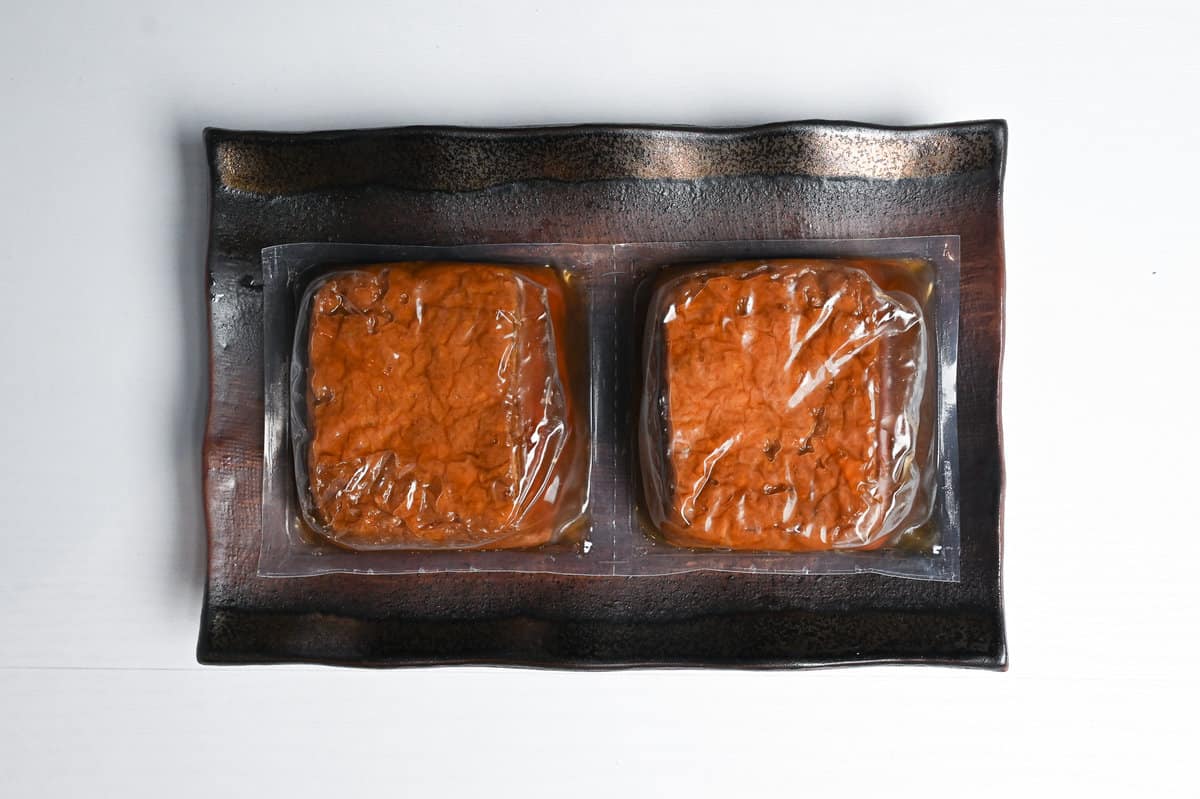 | Pre-simmered sweet-savory | Easiest, no prep | Busy mornings |
Kyo-age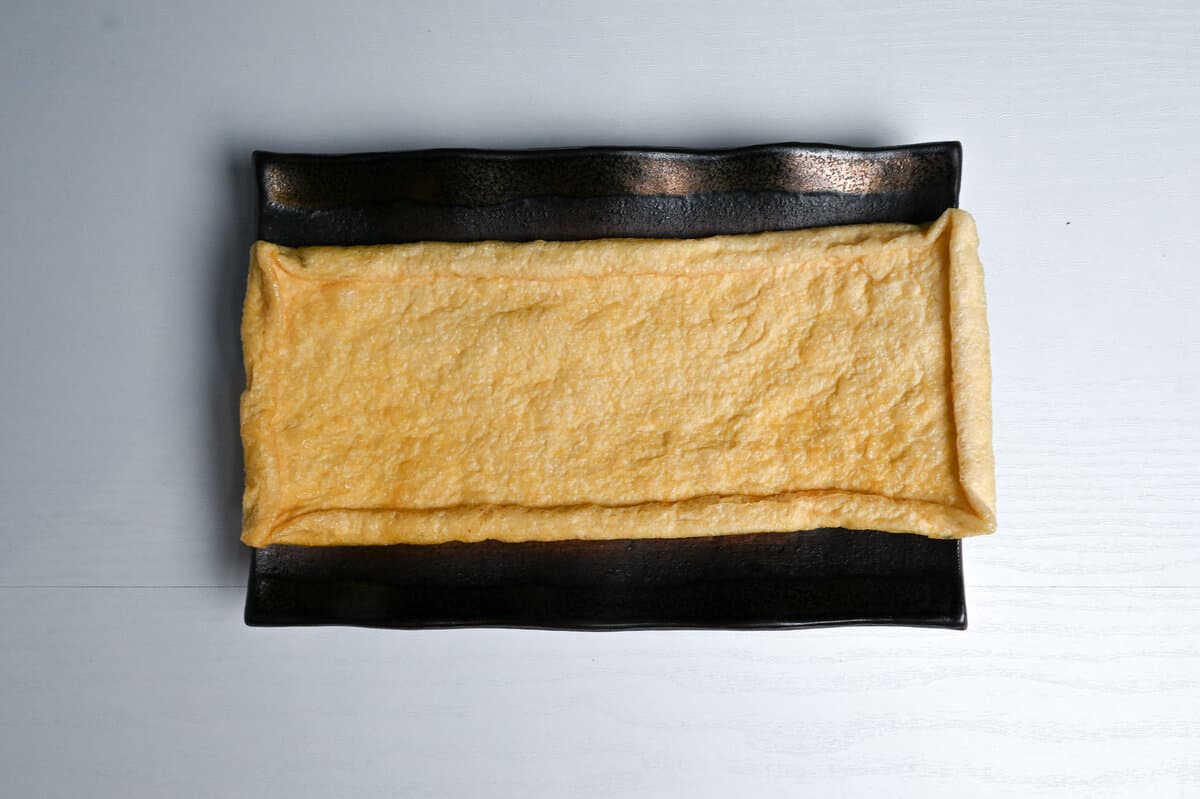 | Thicker cut, some tofu remains inside | Tricky | N/A |
Mukashiage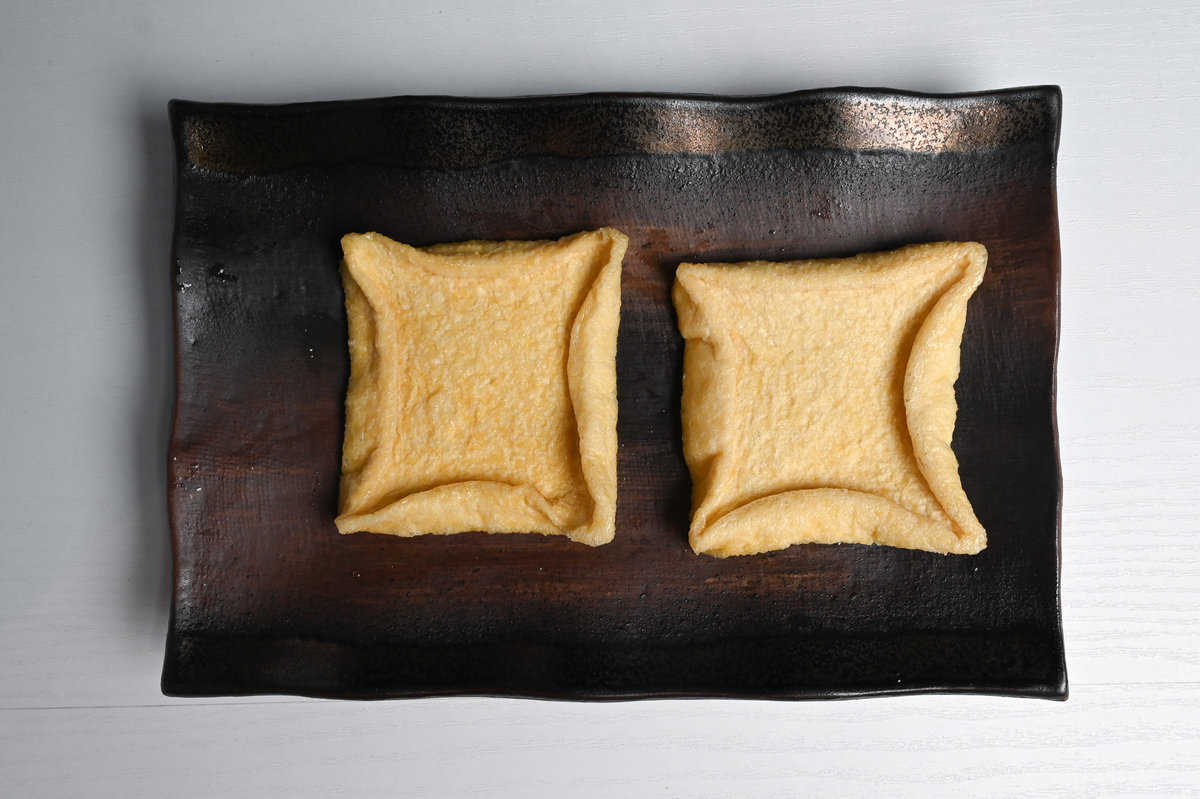 | Thick, moist, tofu-forward | Hard | N/A |
To put it simply, your choice comes down to square thin-sliced tofu or pre-seasoned tofu pouches. Personally, I prefer thin-sliced tofu simmered in homemade broth. The flavor is supreme and pre-seasoned tofu tends to be a bit too salty and sweet.
Still, the ready-made kind is wonderfully convenient, so it’s worth trying both to see which suits your taste and schedule.
How to Make My Inari Sushi
If you prefer to watch the process in action, check out my YouTube video of this Inarizushi recipe!
Before you start: Cook the short-grain rice and prepare the dashi stock.
i. Lay each aburaage on a board and roll firmly with a rolling pin (or a round chopstick/bottle) to loosen the inner layers. This breaks the delicate web inside so the pouch opens cleanly later and fills without tearing.
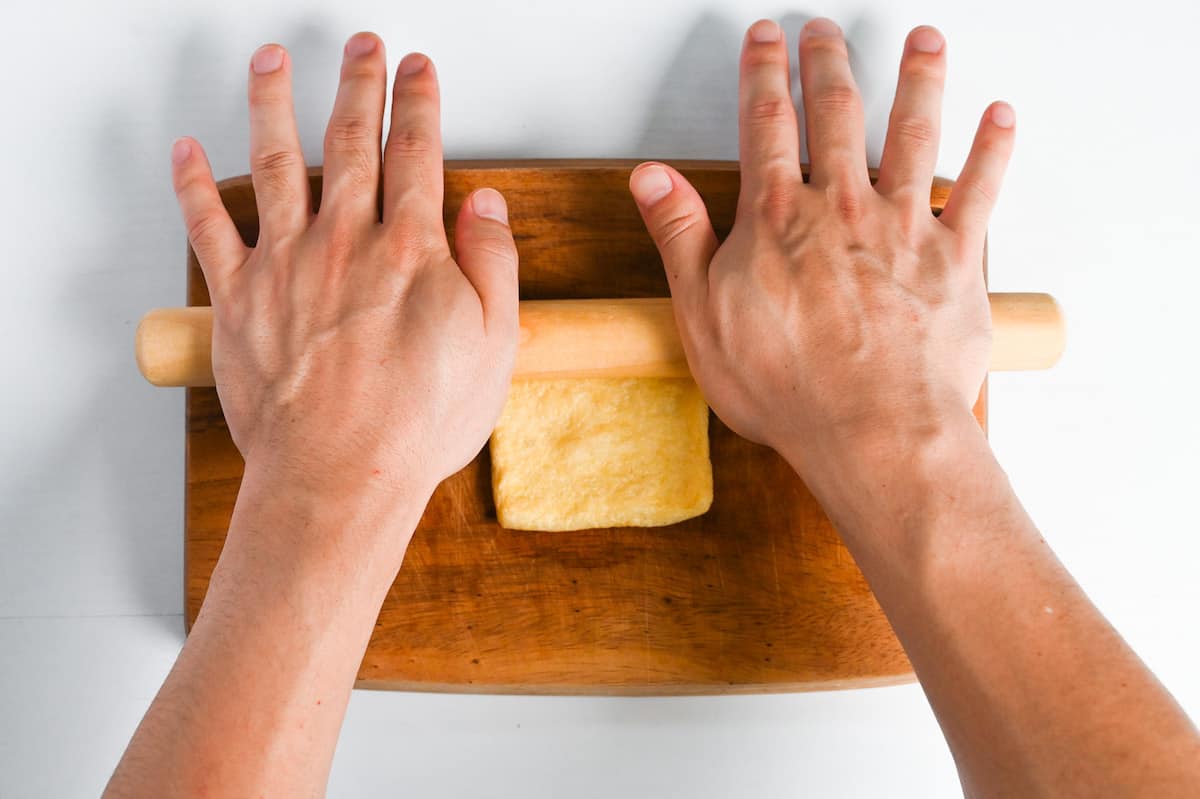
ii. You’ll feel the tofu become slightly more pliable and see faint lines appear. Stop before it cracks. If one does split, keep that piece for the “open-face” topping style explained later.
i. Bring a pot of water to a vigorous boil (100℃/212°F) and add the pouches.
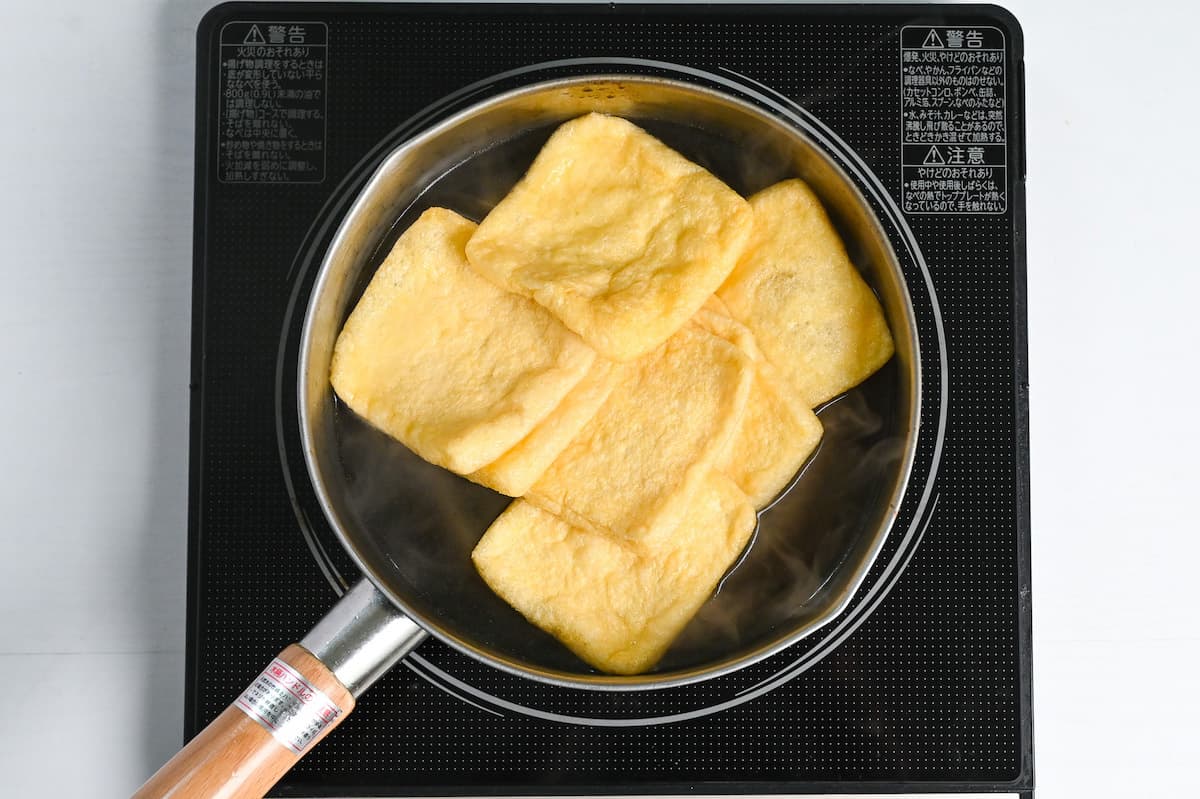
ii. Keep them submerged with a drop lid or heatproof plate for 2 minutes. This “aburanuki” blanch removes factory oil so the tofu absorbs seasoning instead of repelling it.
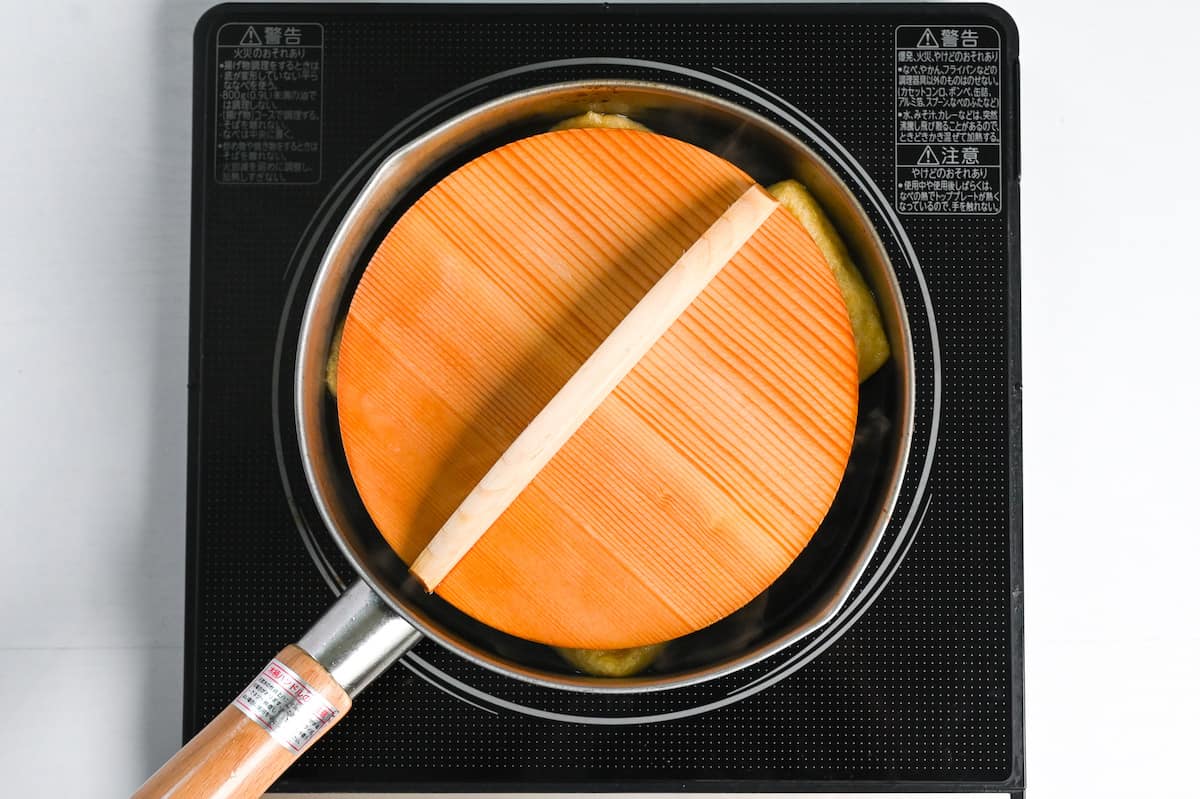
A drop lid (otoshibuta) circulates simmering liquid evenly and holds buoyant pieces under, so they season uniformly without rough stirring. It’s a classic Japanese trick to keep fragile ingredients intact.
iii. You’ll smell the raw oil fade. If the water goes cloudy, you’re doing it right. If you can’t submerge them fully, rotate with tongs to expose all sides.
iv. Tip the pouches into a sieve, rinse under cold water to stop carryover heat, then gently press between palms to remove excess water. This prevents diluted seasoning later and cools them for clean handling.
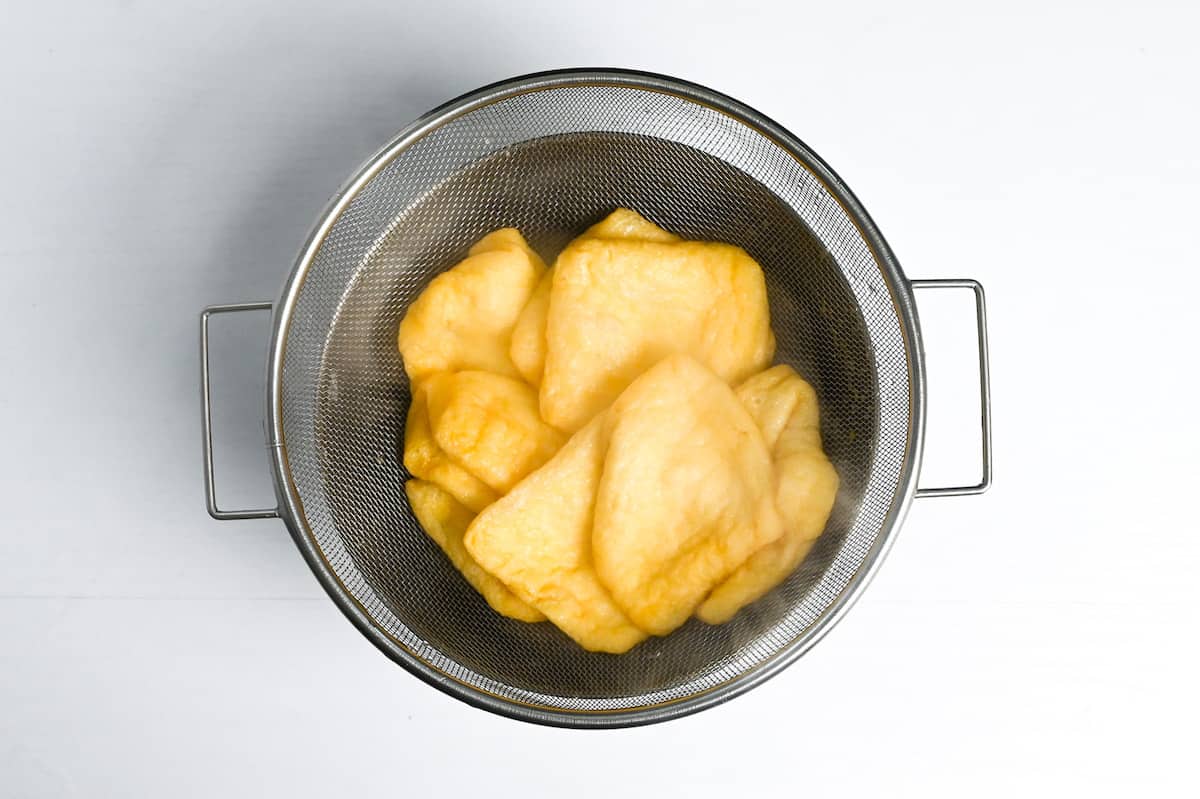
v. Use a sharp knife to trim 2-3 mm off one short edge. That clean cut will be your opening.
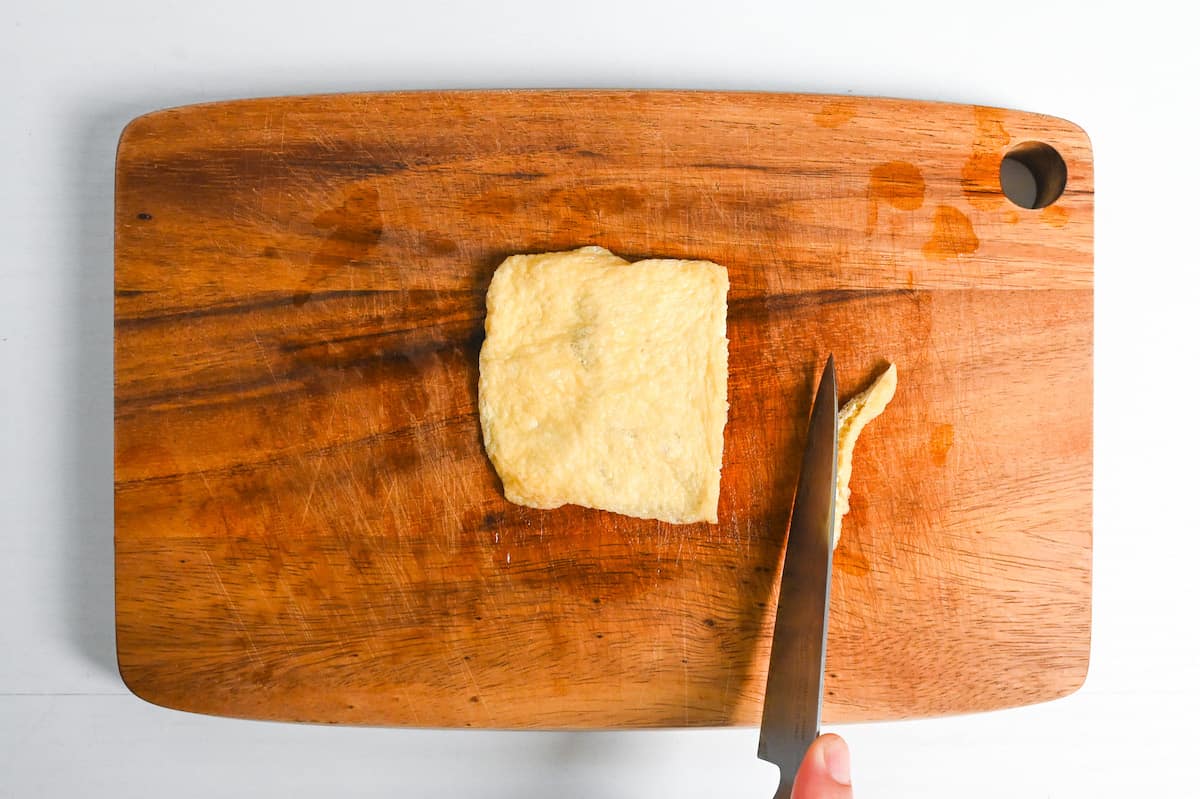
i. In a small pan, combine light soy sauce, dashi stock, mirin, and sugar. Bring just to a boil over medium heat, stirring to dissolve sugar. Aim for a gentle simmer.
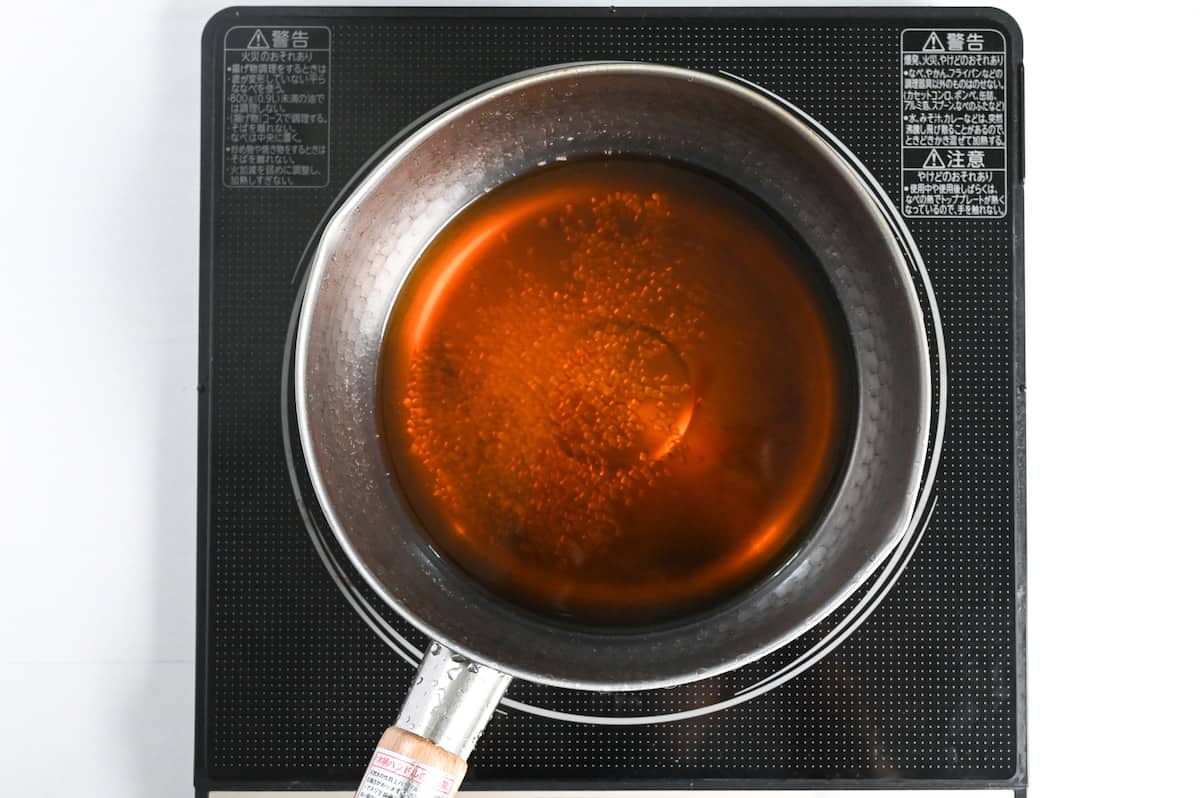
ii. Once you no longer smell alcohol, slide the pouches into the broth.
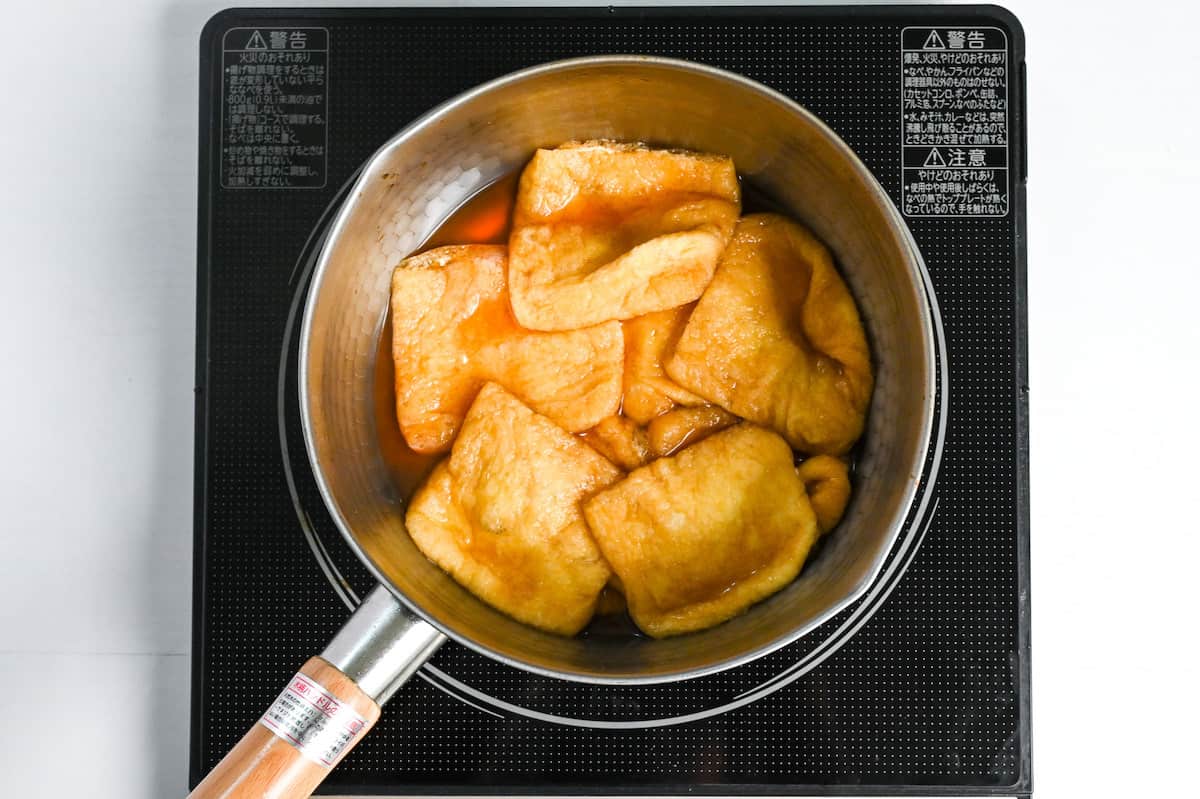
iii. Reduce to a gentle simmer (about 85-96℃/185-205°F), and cover with a drop lid so every piece stays submerged.

iii. Cook until the liquid reduces to about one-third. Avoid vigorous stirring, swirl the pan if needed. If it reduces too quickly, add a splash of water to prevent scorching.
i. Transfer pouches and liquid to a shallow, lidded container; let steam dissipate, then chill to 4℃ (40°F) before sealing.

ii. Rest at least 1 hour (overnight is best) so the seasoning migrates evenly from surface to center.
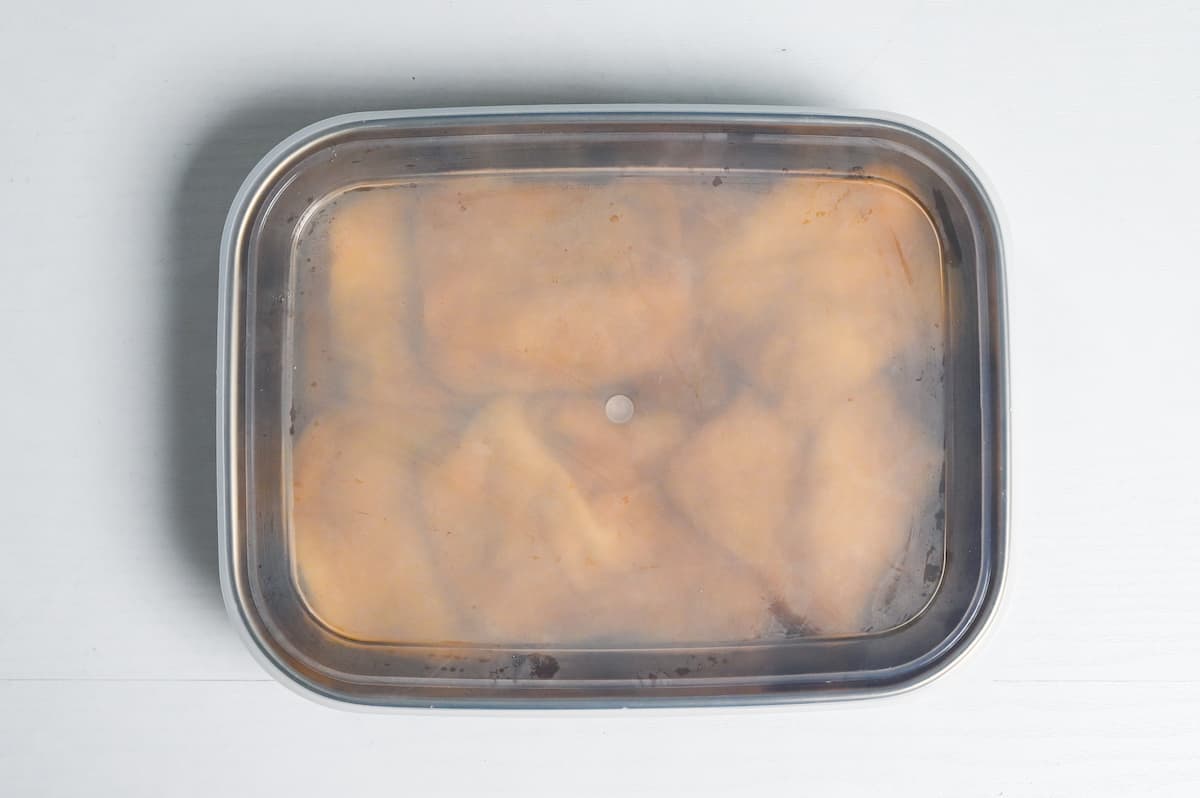
i. Stir rice vinegar, sugar, and salt until dissolved. Spread hot, just-cooked rice in a wide pan or bowl. Drizzle the vinegar mixture.

ii. Then fold with a paddle while fanning until the grains turn glossy and separate yet still tender.
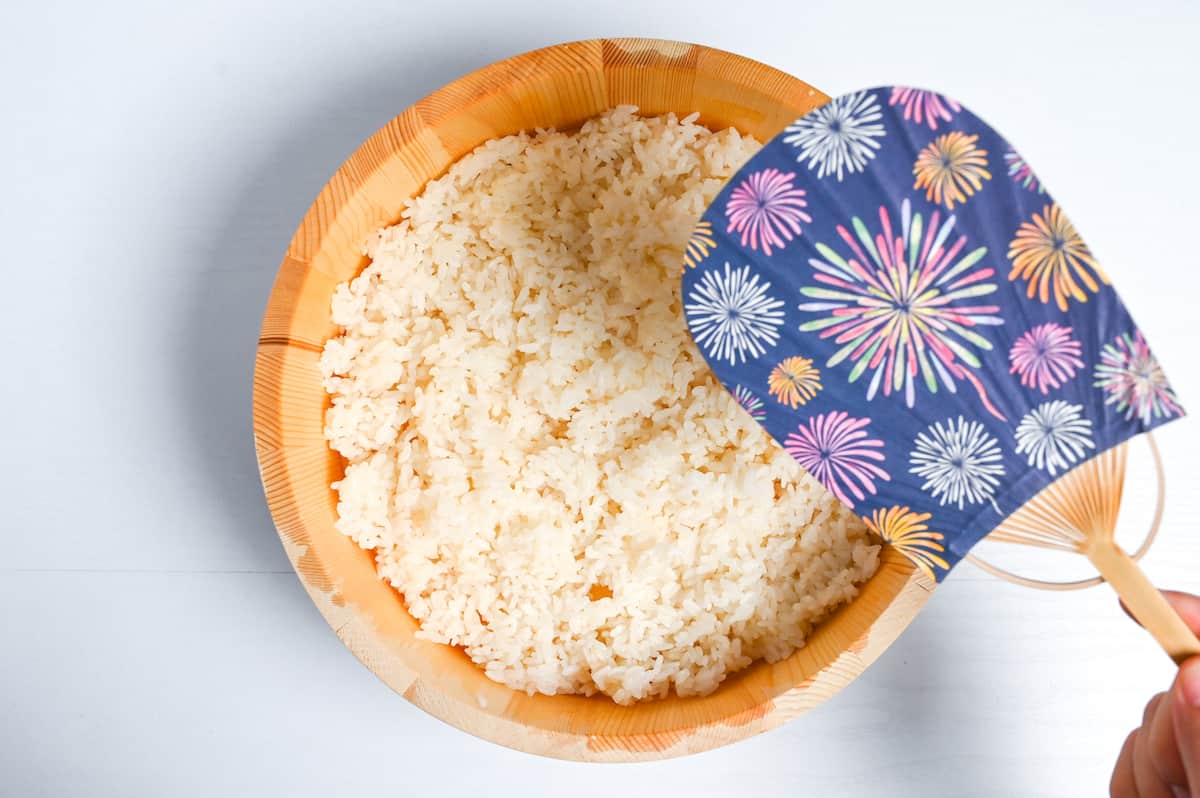
Fanning speeds surface evaporation while the sugar’s humectancy keeps the interior moist, giving that signature sheen and bite. A broad vessel wicks extra moisture so the rice seasons evenly without becoming gummy.
i. Working one at a time, pinch the trimmed edge and gently separate to form a pocket. If you feel resistance, wiggle a fingertip inside to release the inner layer rather than pulling hard.
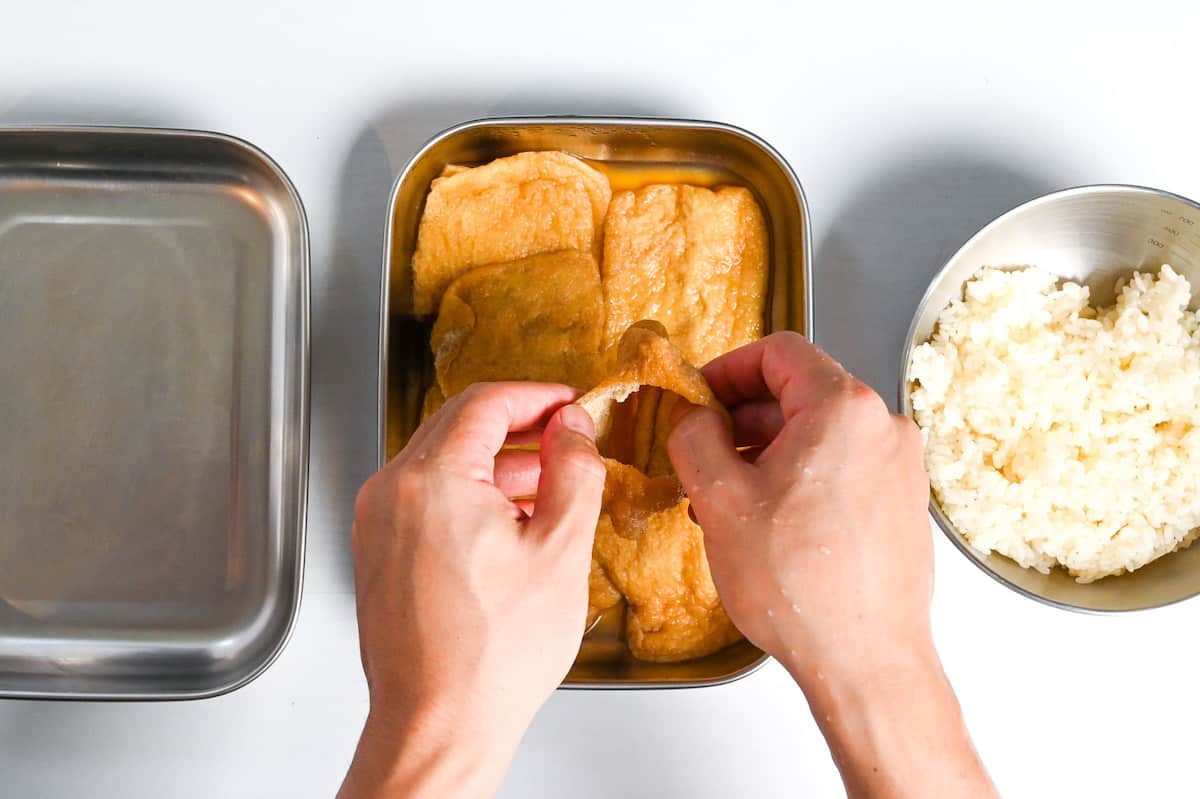
ii. Divide the rice into equal portions, roughly 45-60 g (1½-2 oz) for standard inari. With wet hands, press each portion into a compact barrel that holds together without squeezing out starch. If rice sticks, re-wet your hands. If it crumbles, it’s too cool, cover briefly to trap warmth.
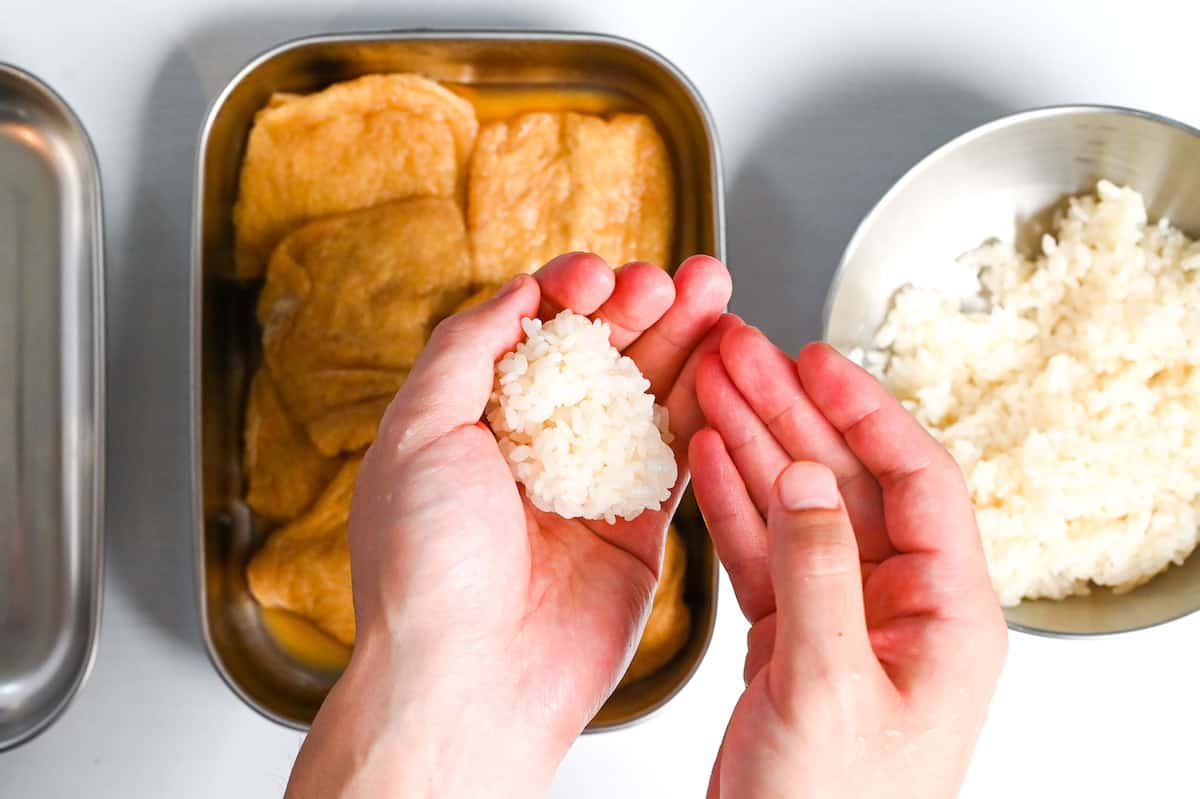
iii. Nestle a rice log into each pouch and tuck the edges around it.
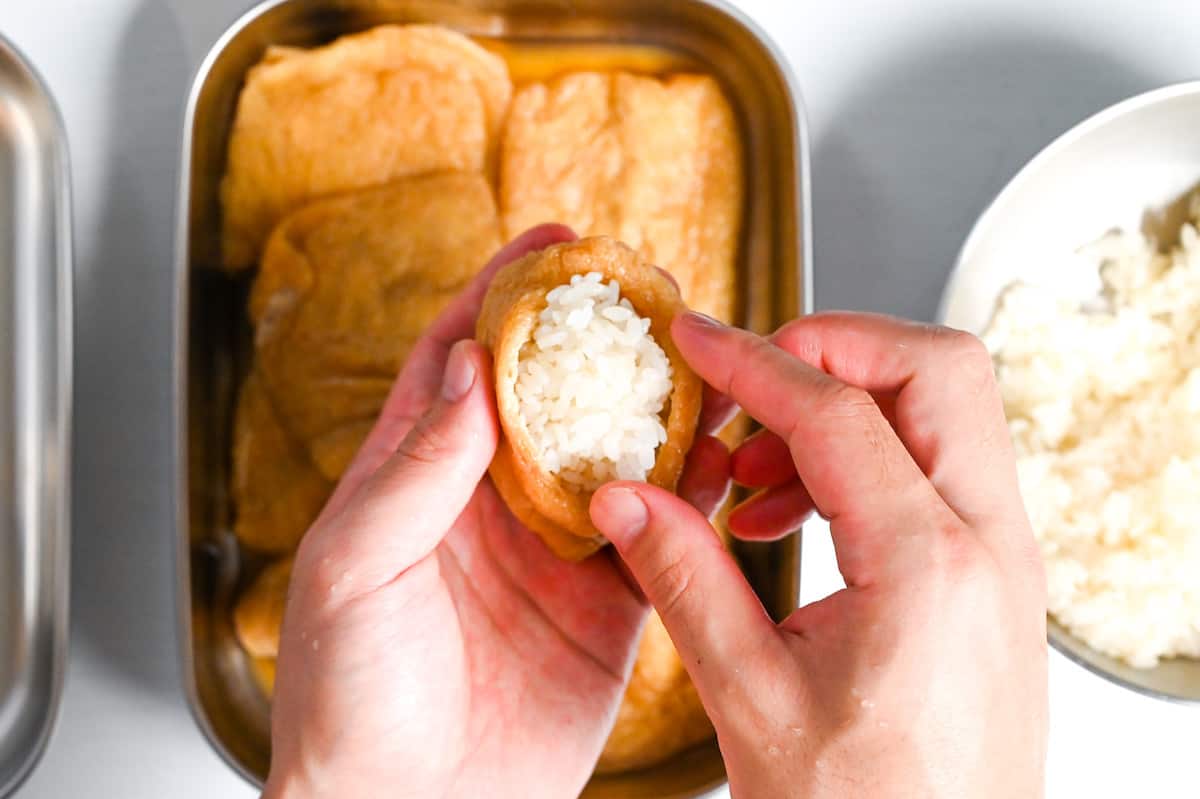
iv. Use the back of a damp spoon to coax the rice into corners, keeping the top surface slightly domed.
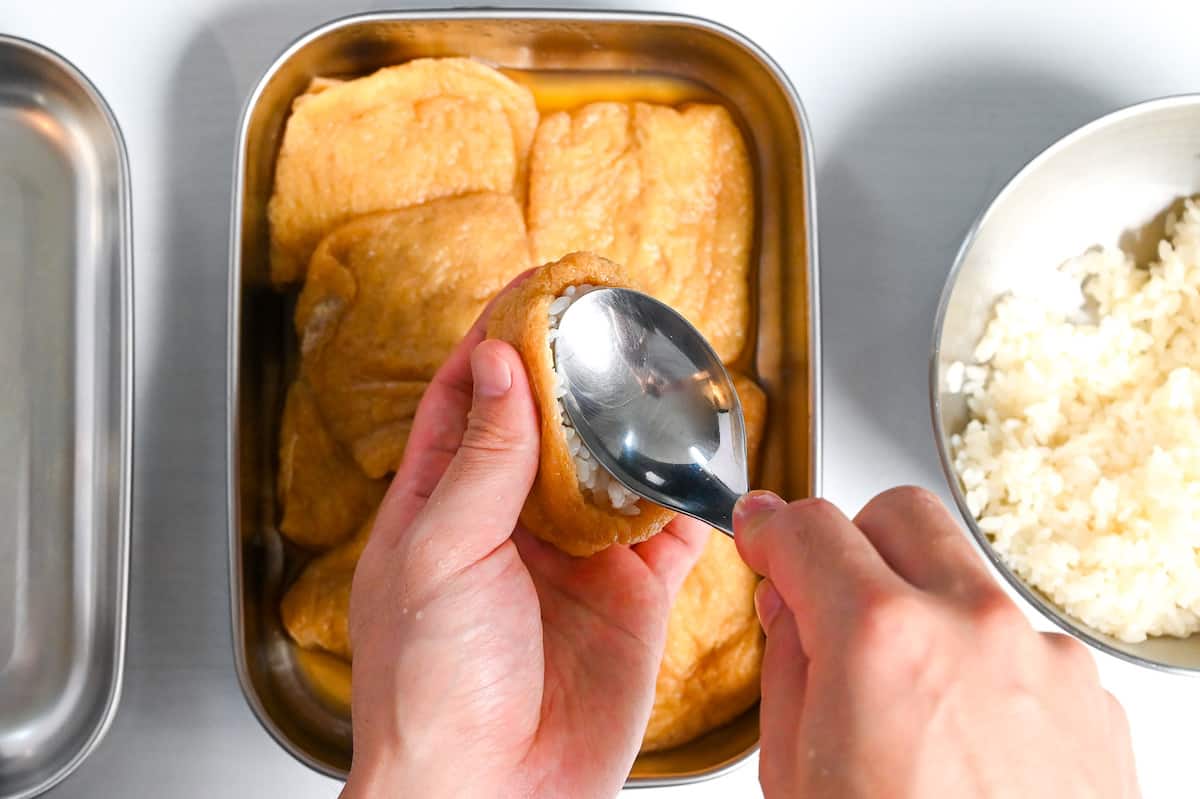
v. Fold excess skin over itself once or twice to create a neat seam.

vi. Then flip seam-side down so it self-seals under its own weight. The surface should look satin-glossy and springy to the touch.

i. For modern open-face inari (nose-inari), trim the folded flap off, leaving ~1 cm of tofu rim to “wall” the rice.

ii. Stand the pouch up.

iii. Spoon on toppings, pressing lightly so they adhere.

- Crab meat and lemon peel: It is topped with canned crab meat and lemon peel. It is very tasty with a dash of soy sauce!
- Smoked salmon and salmon roe (ikura): Salmon and salmon roe are a golden combo for any occasion. A little wasabi paste and a dash of soy sauce complete this nose inari!
- Boiled shrimp and lemon: If you don’t like raw seafood, I recommend using boiled shrimp here! Garnish with lemon for added color and flavor.

Essential Tips & Tricks
- Removing Oil: To enhance the taste of your inari sushi, remove the oil from the fried tofu.
- Using a Drop Lid: Tofu pouches float in liquid, so ensure every piece of tofu is effectively immersed in hot water and thoroughly rid of oil by using a drop lid during boiling.
- Choosing the Right Sugar: While ordinary sugar can be used, Turbinado sugar is preferred. It dissolves slowly during the cooking process, reducing the risk of burning and improves the overall taste.
- Packing the Rice: It’s best to pack the sushi rice when it is moderately warm but not hot. Rice that has cooled down completely may prove difficult to mold since it tends to dry out.
- Filling the Tofu: When filling the fried tofu pouches, it’s easier if the sushi rice is shaped like a bale, similar to nigirizushi. If you use too much force when shaping the rice, it will become too hard, and if it is too soft, it will fall apart when you are eating it. It is important to use the same degree of force as when making rice balls. Essentially press the rice together until it holds its shape, but avoid crushing the rice or pressing too hard.
With these simple tips in mind, you’re set for success every time you make Inari Sushi.
Storage & Meal Prep
Fridge: Seasoned aburaage (skins only): in marinade, airtight container, 2-3 days. Fully assembled inari: quality drops (rice hardens), but you may refrigerate up to 3-4 days, best eaten day-of or next day.
Freezer: Seasoned aburaage (skins only): cool completely, wrap, then bag with air pressed out, up to 1 month. Thaw overnight in the fridge and rewarm gently in marinade. Fully assembled inari: not recommended.
Meal Prep: Best practice is to make and chill the seasoned skins 1-3 days ahead, then cook rice and assemble on the day.
What to Serve With This Recipe
Inari Sushi Q&A
It’s eaten at room temperature or slightly chilled, no dipping sauce needed. Simply pick it up with chopsticks or fingers, seam-side down, and enjoy the contrast of sweet tofu and vinegared rice.
You can freeze the seasoned tofu pouches for up to 1 month. Fully assembled inari sushi can be frozen but I don’t recommend it as it may lose its ideal rice texture after thawing. Best to fill fresh.
Inari sushi originated in Japan’s Edo period (1603-1868) as an affordable, portable dish loved by common people. It first appeared in the record Morisada Mankō (守貞漫稿), which described how inarizushi spread across Edo, Kyoto, and Osaka for its sweet-savory flavor and convenience. By the mid-19th century, Kinsei Akinai Zukuri Kyōka-awase (1852) depicted “furi-uri” vendors selling it from baskets or wooden boxes as they walked the streets. Toward the end of the Edo era, these roaming sellers gave way to the first specialty inarizushi shops, showing its lasting popularity.

More Japanese Sushi Recipes
- Temari Sushi (Bitesize Sushi Balls)
- Salmon Sushi Rolls
- Ehomaki (Lucky Direction Sushi Rolls)
- Temaki Sushi (Hand Roll Sushi)
Ready to roll? Discover a variety of easy sushi recipes that make homemade sushi accessible and delicious.
Did You Try This Recipe?
I would love to hear your thoughts!
💬 Leave a review and ⭐️ rating in the comments below. 📷 I also love to see your photos – submit them here!

Inari Sushi (Inarizushi)
Ingredients
Seasoned Tofu Pouches
- 8 sheets fried tofu pouch (aburaage) plain, unseasoned
- 2 tbsp Japanese light soy sauce (usukuchi shoyu) or regular Japanese soy sauce
- 200 ml dashi stock use plant-based dashi to make it vegetarian/vegan
- 1 tbsp mirin
- 25 g turbinado sugar
Sushi rice (sumeshi)
- 320 g cooked Japanese short-grain rice or medium-grain, avoid long-grain or jasmine rice
- ¾ tsp salt
- ½ tbsp sugar
- 1 tbsp rice vinegar unseasoned
Additional Toppings (optional)
- boiled shrimp peeled and deveined
- lemon
- marinated salmon roe (ikura)
- smoked salmon or sashimi-grade salmon or other fish
- crab meat canned or fresh
My recommended brands of ingredients and seasonings can be found in my Japanese pantry guide.
Can’t find certain Japanese ingredients? See my substitution guide here.
Instructions
- Roll and flatten 8 sheets fried tofu pouch (aburaage) using a rolling pin.

- Bring a small pot of water to a boil and then add the tofu pouches.

- Place a drop lid on top to help submerge them into the water and boil for 2 minutes.

- Pour the contents of the pan into a mesh sieve to drain and then wash with fresh cold water. Squeeze the tofu pouches to remove the excess water and transfer them to a chopping board.

- Cut one edge of the tofu pouch to make an entry point for your fillings.

- Take a small sauce pan and add 2 tbsp Japanese light soy sauce (usukuchi shoyu), 200 ml dashi stock, 1 tbsp mirin, 25 g turbinado sugar and bring to boil.

- Once boiling, add the washed and trimmed tofu pouches.

- Turn the heat down to a simmer and place the drop lid on top. Simmer until the liquid is reduced to one-third of the original volume.

- Pour the contents of the pan into a sealable container and leave to cool.

- Once cool, place the lid on and marinate in the refrigerator for at least one hour, preferably overnight.

- Mix ¾ tsp salt, ½ tbsp sugar and 1 tbsp rice vinegar in a small bowl until the sugar has dissolved, then pour it into 320 g cooked Japanese short-grain rice.

- Mix until evenly distributed, fan as you mix to help cool the rice down quickly.

- Once the rice is cool enough to touch, carefully open the tofu pouches.

- Divide the sushi rice into equal portions for each pouch and then shape into an oval-shaped ball.

- Push the rice into the pouch.

- Gently press the rice down using the back of a spoon.

- Close the pouch by folding over the edge.

- Flip it over and serve. (If using toppings, following the instructions below.)

Additional toppings
- Instead of folding the edge to seal, trim the excess tofu pouch using scissors.

- Open the pouch.

- Place your choice of toppings inside.

- Enjoy!





I have been making inarizushi for decades and this article opened my eyes in many ways. Will make use of all the “tips”!
Hi Jan,
Thank you very much for your comment! I’m glad the article is informative! I hope it will turn out great! 🙂